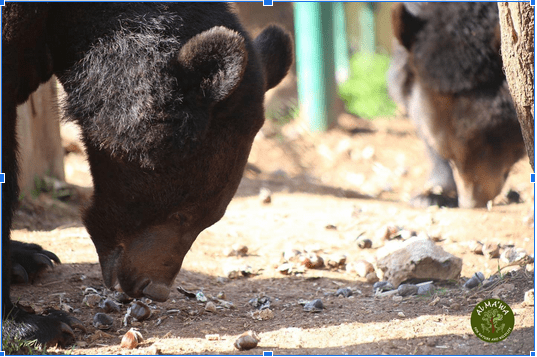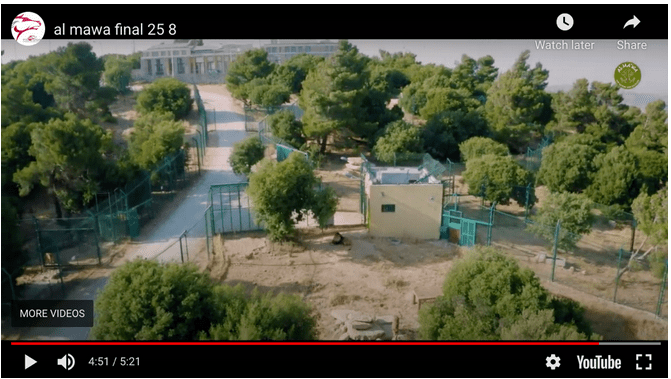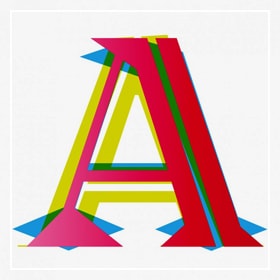This essay considers the role of demonstration as a technique of trust at a wild animal sanctuary in Jordan. I suggest that demonstration is an important technique of trust because of its narrative flexibility in conveying trust to multiple audiences at once.
When they first arrived at Al Ma’wa wildlife sanctuary in northern Jordan, Loz and Sukkar (Arabic for Almonds and Sugar) were withdrawn, wary of people, and cowered in their secluded night rooms every time a car backfired or helicopter flew by. The two Asian Black Bears came to Al Ma’wa in 2017 with a small contingent of eleven other wild animals – lions, hyenas, dogs, and tigers – who were rescued from Magic World Zoo in Aleppo, Syria. These were the lucky thirteen, the sole survivors at a zoo that had sustained years of damage and neglect during Syria’s war; despite the efforts of the zookeeper and several Syrian volunteers, the other two hundred animals had already died of starvation, dehydration, and injuries incurred from stray bullets and bombs.
Yusuf, one of Al Ma’wa’s head animal caretakers, came to see the behaviour of Loz and Sukkar as a kind of animal PTSD (post-traumatic stress disorder) – evidence that the bears were traumatised to their core from the constant gunfire and bombs from Syria’s war – and he made it his goal to rehabilitate them and help them learn to trust again. Over the course of two years, Yusuf worked with an animal care team to devise a range of trust-building exercises for the bears that included enrichment activities involving food, puzzles, and novel forms of play. These activities, explained Yusuf, were also designed to help the animals see that this was a new, safe world: “We tried to disconnect them completely from their previous experience, as if they were born the day they came to Al Ma’wa.”
But down the road from Al Ma’wa, some humans don’t trust these animals. In the small town of Souf, Um Mahmoud, a great-grandmother in her mid-seventies, was sympathetic to the plight of the animals at Al Ma’wa, but, like Loz and Sukkar, she was wary. When I talked with her in her home in 2019, a year after Al Ma’wa had opened to the public, she still hadn’t visited and was particularly concerned about the lions and tigers who were now her new neighbours. She told me: “We haven’t gone there yet because we’re scared. People need to be very cautious, especially if they have small children, right?” Like the other residents of Souf and the nearby city of Jerash, Um Mahmoud was at best ambivalent about the entire enterprise of Al Ma’wa, mistrusting of both the expertise of Al Ma’wa’s staff, the security of the site’s animals, and the general rationale behind Al Ma’wa’s existence. These are top predators, after all, as many of my interlocutors reminded me, and ones who could pose a real threat to humans around them.
The particularities of how trust is materialised in the world – whether through demonstration or other techniques – matter.
To demonstrate the sanctuary’s security, Al Ma’wa provided free tours of their site to local residents. When they got reports of escaped animals and scared neighbours, they invested in drone surveillance equipment and invited local police chiefs, mayors, park rangers, and others in prominent security positions to tour the facilities as well. Local newspaper articles documented these tours and the results of the drone investigations. As Jafar, one of Al Ma’wa’s directorial staff, explained to me, this went a long way in helping to create a sense of safety, accountability, and trustworthiness. When Yusuf served as tour guide for visitors from Souf, he recalled their anxiety about the site: “’Is it safe (āmana)? Should we go in? Should we trust you (bniqdar nūthaq fīq)? During the tour if an animal gets out of its enclosure, can you catch it?’ We answered: ‘When you take the tour you will find that the design is completely different from what you imagine and then you will understand how safe it is.’ And people came.” Jafar elaborated: “[They] saw with their own eyes what is here. They feel safe. Safe. And they understand that we have nothing to hide.”

How is demonstration a technique of trust? How do demonstrations bring trust forth into the world? A variety of performative acts could be framed as demonstration – for instance, the presentation of medical documents as demonstration of deservingness for asylum (Fassin and D’Halluin 2005), or the museum exhibition as demonstration of colonial triumph (Adedze 2008). But at Al Ma’wa, demonstrations of the site’s safety and security more closely mimic the use of demonstration in scientific, technological, and corporate practice: the product ‘demos’ that routinely accompany the public launch of a new technological product, or the demonstration of a scientific innovation for both lay and expert audiences. These demonstrations are often theatrical (Simakova 2010, Smith 2009) and include a deliberate, step-by-step narrative of the thing in question, a performance that says, “See this? It is here before you; it works, and it is real.”
How do demonstrations bring trust forth into the world?
At Al Ma’wa, demonstrations of this sort heavily feature the materiality of the site itself. This is the case for both the animals who live at Al Ma’wa and the humans, like Um Mahmoud, who live nearby. Yusuf and other caretakers believe that while the high, electrified fences that surround every enclosure (Figure 2) assure humans on the outside, the animals on the inside feel safe not in spite but because of the materials of their captivity – their perimeter fences, their scheduled meals, their enrichment games, and their material engagement with the grass, trees, dirt and rocks that now form their environment. These materials, as Yusuf explained, also convince the animal that it has everything it needs inside of its enclosure, so that it won’t escape: “The animal knows that this place where it stays is safe, so there is no need to risk it and go a mysterious place that (it) doesn’t know.” Caretakers like Yusuf characterise this materiality not as a form of captivity and domination, but rather as producing feelings of safety, security, and life renewed.

With this in mind, staff demonstrate the parameters of the animals’ enclosure to them by inducing them to experience it with their bodies and senses. When animals first arrive, the voltage of the electric fences is lowered so that they can slowly come to understand what the fences are meant to do by encountering the (gentle) shock of the electricity with their bodies (McClellan 2021). For the bears, who have an excellent sense of smell, Yusuf sprays women’s perfume in the far corners of their enclosure to compel them to explore. Likewise, he puts boxes and other interesting objects in trees for the lions and tigers to encourage them to explore vertically as well. Importantly, these activities continue throughout the years; animals must be shown, again and again, that their homes are safe, and that they can trust in that continued safety.

For people like Um Mahmoud, trust in the site’s security also comes from demonstrations of the material infrastructure at Al Ma’wa – the nine-meter-high enclosure fences, triple-locked cages, electrical barriers, and back-up generators that keep the animals in place. When I attended a tour of Al Ma’wa in 2019, several visitors asked about the fences and wondered how staff were so sure the animals couldn’t escape. Our tour guide Rashid – also an animal caretaker – launched into an explanation about the voltage of the fences and the back-up generators that work on-site; he had been versed in how to answer these kinds of questions from the public with the technical language of security. Drones, too, are used to quell these fears in two ways: one, as a measure of response after rumours of lion escapes, which, reflective of the mistrust some residents feel about the site (Carey 2017; West and Sanders 2003), circulate periodically in nearby towns and villages; and two, in promotional footage used on Facebook and other media to provide birds-eye views of the sanctuary’s security fences. Referring to a promotional video, one staff member explained: “one of the main targets of the video was to show people the height of the enclosures and the electrical wirings and to show how safe it is” (Figure 3). These technologies of trust have the ability to dazzle those who are unfamiliar with them, with their expense, technology, and looming physical presence.
This dual meaning speaks to the semiotic potential of infrastructure (…) and is what makes it possible for material tools of captivity and capture to also symbolise freedom and safety.
For humans and animals alike, demonstrations of trust are used to communicate the same thing: you are safe here – but also, you are safe from each other. This dual meaning speaks to the semiotic potential of infrastructure – its ability to be designed for multiple audiences, and for multiple, even sometimes opposing, intentions (see also Larkin 2018). This potential is what makes it possible for material tools of captivity and capture to also symbolise freedom and safety. But, at Al Ma’wa, it is also the demonstration of this material trust that is important: demonstration helps to imbue what would otherwise be mundane or generic materials with trustworthiness, and, importantly, the specificity of that trustworthiness. Demonstration, in this sense, crafts a particular narrative about particular forms of trust for different audiences. Animals are subject to demonstrations about aspects of their enclosures that do not matter to the humans who visit, and humans are shown aerial images from drone technology – something that does not matter (or is not legible) to the animals in question.
All of this is to say that the particularities of how trust is materialised in the world – whether through demonstration or other techniques – matter. But if we consider the role demonstration plays as a technique of trust, we can also begin to trouble normative treatments of trust as a kind of freedom – something borne of choice, free will, and the right to discern what is trustworthy and what is not. In theory, the point of the demonstration is to allow audiences, whether human or animal, to determine for themselves whether they should or should not trust. One can easily see this as a choice in something like a product launch: the demonstration either works or fails to engender trust in the product. But is trusting in the demonstration or in the technologies of security and safety at Al Ma’wa a choice? What would it mean for Loz and Sukkar to refuse to trust in their own safety in their new home? – in the food provided to them, or the protection of their enclosure, or the good intentions of the humans who care for them? Would it mean a certain kind of death, or a certain kind of curtailed life? And what of the residents of Souf and Sakib, who, by some standards, are held captive by their sudden proximity to wild animals?
How is trust built when refusal to participate is simply not a choice?
One way to think through these questions is to consider how trust is built when refusal to participate is simply not a choice. Matthew Carey makes the point that trust involves “managing the freedom of others” (2017, 10) as well as controlling that freedom; at Al Ma’wa, the freedom of both human and animal audiences to refuse trust is both managed and controlled through crafted narratives and material demonstrations. The way in which trust operates in other war contexts where security infrastructures frame daily life also reveals how trust works when there is no accountability, no confidence, and no other choice – it must work, or everything collapses; or, perhaps everything collapses anyway, you never know (Rubaii 2019). At Al Ma’wa, different iterations of trust are brought into being despite, and because of, the fact that Al Ma’wa operates through regimes of captivity. At Al Ma’wa, animals and humans alike are audiences for which trustworthiness is demonstrated by staff to achieve certain goals – namely, happy, docile animals and cooperative, supportive neighbours. And yet, these formations of trust work within a captive setting, where animals are enclosed in spaces surrounded by high, electrified fencing, and where residents in neighbouring towns may hear lions roaring in the night: there is no choice but to trust in the steel, the data, and promises of safety offered in demonstration itself.
References
Adedze, Agbenyega. 2008. Symbols of Triumph: IFAN and the Colonial Museum Complex in French West Africa (1938-1960). Museum Anthropology 25(2): 50-60.
Carey, Matthew. 2017. Mistrust: an ethnographic theory. Chicago: Hau Books.
Fassin, Didier and Estelle D’Halluin. 2005. The Truth from the Body: Medical Certificates as Ultimate Evidence for Asylum Seekers. American Anthropologist 107(4): 597-608.
Larkin, Brian. 2018. “Promising Forms: The Political Aesthetics of Infrastructure.” In The Promise of Infrastructure, edited by Nikhil Anand, Akhil Gupta, and Hannah Appel, 175-202. Durham, NC: Duke University Press.
McClellan, Kate. 2021. Electric Refuge: The Shock of Animal Infrastructure in Jordan. Roadsides 6: 24-29. https://doi.org/10.26034/roadsides-202100604
Rubaii, Kali. 2020. Trust without Confidence: Moving Medicine with Dirty Hands. Cultural
Anthropology. 35(2): 211-217. https://doi.org/10.14506/ca35.2.03.
Simakova, Elena. 2010. “RFID ‘Theatre of the proof’: Product launch and technology demonstration as corporate practices.” Social Studies of Science 40 (4): 549-576.
Smith, Wally. 2009. Theatre of Use: A Frame Analysis of Information Technology Demonstrations. Social Studies of Science 39(3): 449-480.
West, Harry G., and Todd Sanders. 2003. Transparency and conspiracy: ethnographies of suspicion in the new world order. Durham: Duke University Press.
IMAGE: Patterns and Textures by Jonathan Reyes, on Flickr (CC BY-2)





